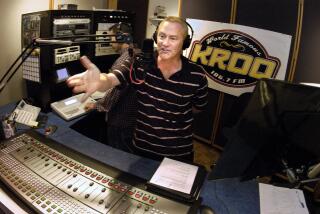Colorful DJs rocked the talk in the AM radio wars of the ‘60s
- Share via
It was the case of the missing DJ.
When a Pasadena radio station rechristened itself KRLA and began to rock and roll in 1959, one of its jocks, Perry Allen, was absent. KRLA started a “Find Perry Allen” campaign and promised $10,000 to any listener who could track him down in those pre-Google days.
What mischievous KRLA didn’t say was that it knew where Allen was: working at his old station in Buffalo, waiting for his contract to expire.
But KRLA’s rival, KFWB, knew. And KFWB sent two representatives to Buffalo to confront Allen and claim the $10,000, wrote ex-jock Bob Eubanks in “It’s in the Book, Bob,” co-written by Matthew Hansen. KRLA grudgingly paid, then tried to capitalize on its own misfortune with the slogan, “Even KFWB listens to KRLA.”
KFWB is known these days as an all-news station that recently switched to a talk format. But in the 1950s and ‘60s, it was part of the wacky world of AM rock music, competing fiercely in Southern California against KRLA (1110) and KHJ (930) before the superior FM stereo sound caught on in the 1970s.
The AM wars were a time of colorful DJs with colorful trademarks.
KRLA’s self-anointed “Emperor,” Bob Hudson, had this sign-off: “Get off the freeways, peasants. His Highness is coming.”
Over at KHJ, the mantra of the “Real Don Steele” was a recorded woman’s voice that cried, “Tina Delgado is alive, alive!” The mysterious Steele died in 1997, never having divulged its meaning.
KFWB was the first station in Los Angeles to sense the commercial possibilities of baby boomers.
In 1958, the station unveiled a Top 40 song format, calling itself “Color Radio, Channel 98.” The term referred to color television, which was catching on.
Program director Chuck Blore made personalities out of his jocks, including Bill Ballance, B. Mitchel Reid and Ted Quillin, dubbing them the “Seven Swingin’ Gentlemen.”
KFWB became No. 1, and Blore wanted to make sure it stayed that way.
As recounted on laradio .com, Blore once phoned a bored-sounding DJ and said, “You’re on the radio, jerk! After the next record, I want you to say there is an amoeba loose and ladies with butterfly nets are chasing [it].” All day the station broadcast amoeba updates to listeners.
KRLA (formerly KXLA) arrived in 1959 with a younger set of DJs including Jimmy O’Neill, who was all of 19. The “1110 Men” made the “Seven Swingin’ Gentlemen” seem ancient.
“Kids huddled beneath their bed covers, listening on transistor radios to such inimitable personalities as Huggy Boy, Humble Harv, Emperor Hudson, Dave (the Hullabalooer) Hull, Casey Kasem and Johnny Hayes,” The Times’ Steve Hochman wrote.
On Hull’s first day, not more than 10 seconds into his first record, the free-spirited DJ asked listeners, “Well, how do you like the show so far?” recounted Bill Earl in “Dream-House,” his history of KRLA.
Listeners liked it. KRLA rose to No. 1, but the competition was fierce. When KRLA obtained the Trade Winds’ yet-to-be-released “New York’s a Lonely Town,” the station added two spoken lines to the song so neither KFWB nor anyone else could pirate it off the airwaves.
The end product sounded like this: “From Central Park to Pasadena’s such a long way/ And there’s no KRLA/ I feel so out of it walkin’ down Broadway/Sure do miss KRLA.”
KHJ entered the AM rock wars in 1965, discarding its mellow-sounds approach. Promotion director Clancy Imislund, noticing that kids were constantly using the word “boss” (translation: outstanding), suggested the concept “Boss Radio.”
But the idea was leaked to KFWB, apparently by a fired KHJ employee. KFWB liked the concept too.
One morning, KFWB began airing commercials announcing that the station would become “Boss Radio.” KHJ program director Ron Jacobs immediately called a meeting to announce that KHJ would become “Boss Radio” that afternoon at 3, rather than weeks from then as originally planned.
“Then I realized I had forgotten something: music,” Jacobs wrote in his memoir, “KHJ: Inside Boss Radio.”
No music research had been done. An employee was sent over to Wallach’s Music City to pick up “a KRLA song list and two copies of all the records on it,” he said.
Within six months, KHJ went from 12th in the local ratings to first.
Jacobs and program consultant Bill Drake emphasized the music, with less chatter from the DJs, though they made exceptions for such strong personalities as cantankerous Robert W. Morgan and the edgy Steele.
The Times’ Myrna Oliver once reproduced this bit of Steele’s semi-intelligible chatter:
“It’s 3 o’clock in Boss Angelese! Hey, hey, HEY! Thitz me. The Real Don Steele. A billion-dollar weekend there. . . . I got nothing but groovy, those groovy golds. We’re gonna kick it out here on a fractious Friday, boy. Got to get a set outside that (unintelligible) work resembling blowing bubbles in a glass of water!”
The bubbles began to burst for “Boss Radio” in the 1970s when Steele and Morgan -- and their listeners -- moved to FM. KHJ is now a Spanish-language station.
KFWB dropped music in 1968. KRLA’s call letters were changed to KDIS (for Radio Disney).
Tina Delgado’s whereabouts are still unknown.
--
steveharvey9@gmail.com
More to Read
The biggest entertainment stories
Get our big stories about Hollywood, film, television, music, arts, culture and more right in your inbox as soon as they publish.
You may occasionally receive promotional content from the Los Angeles Times.










